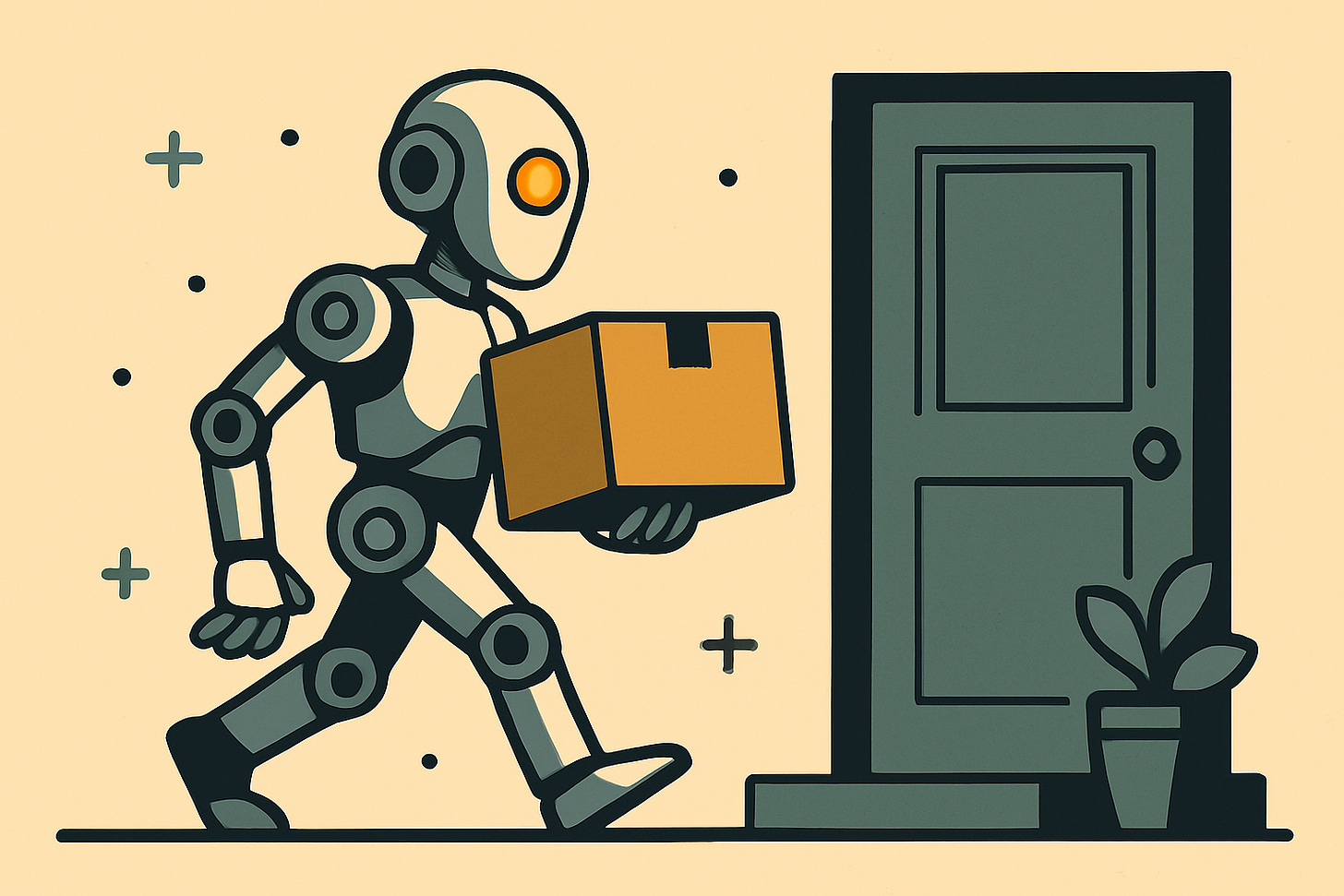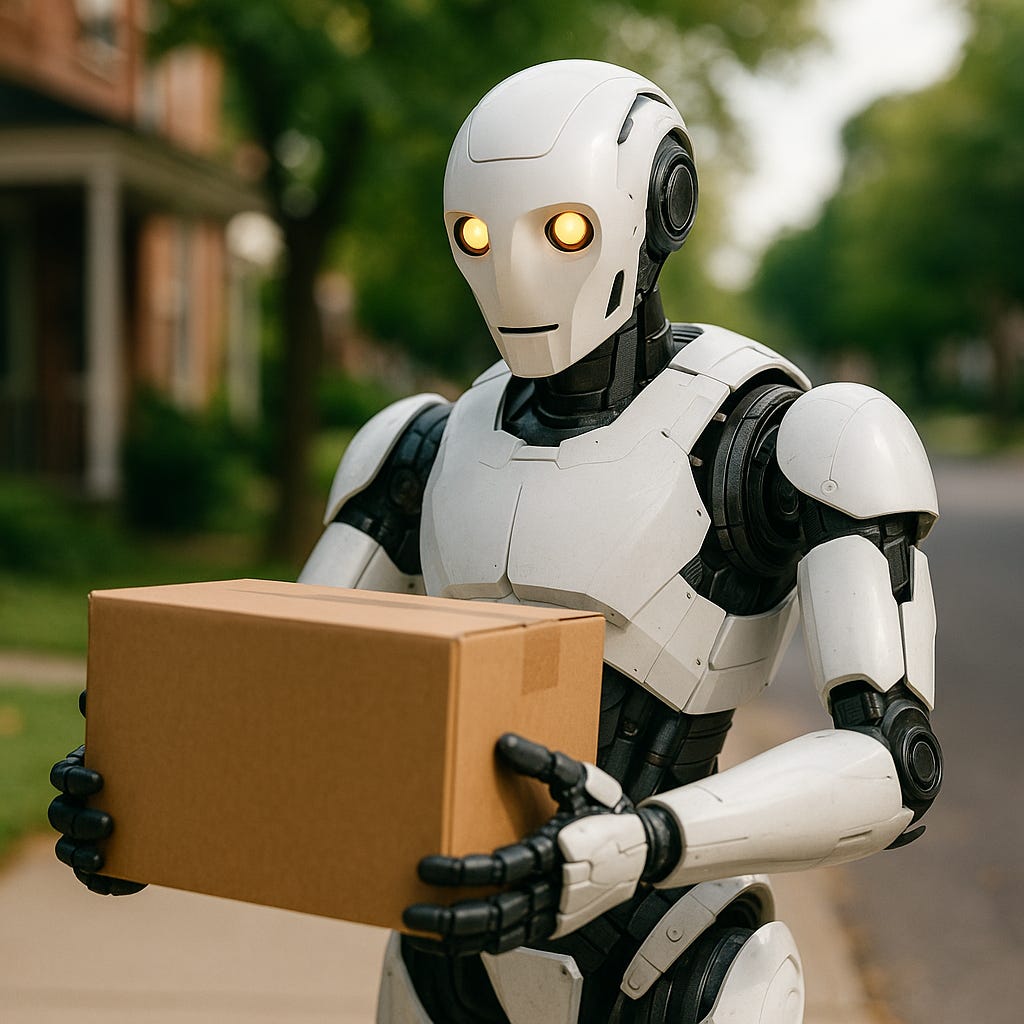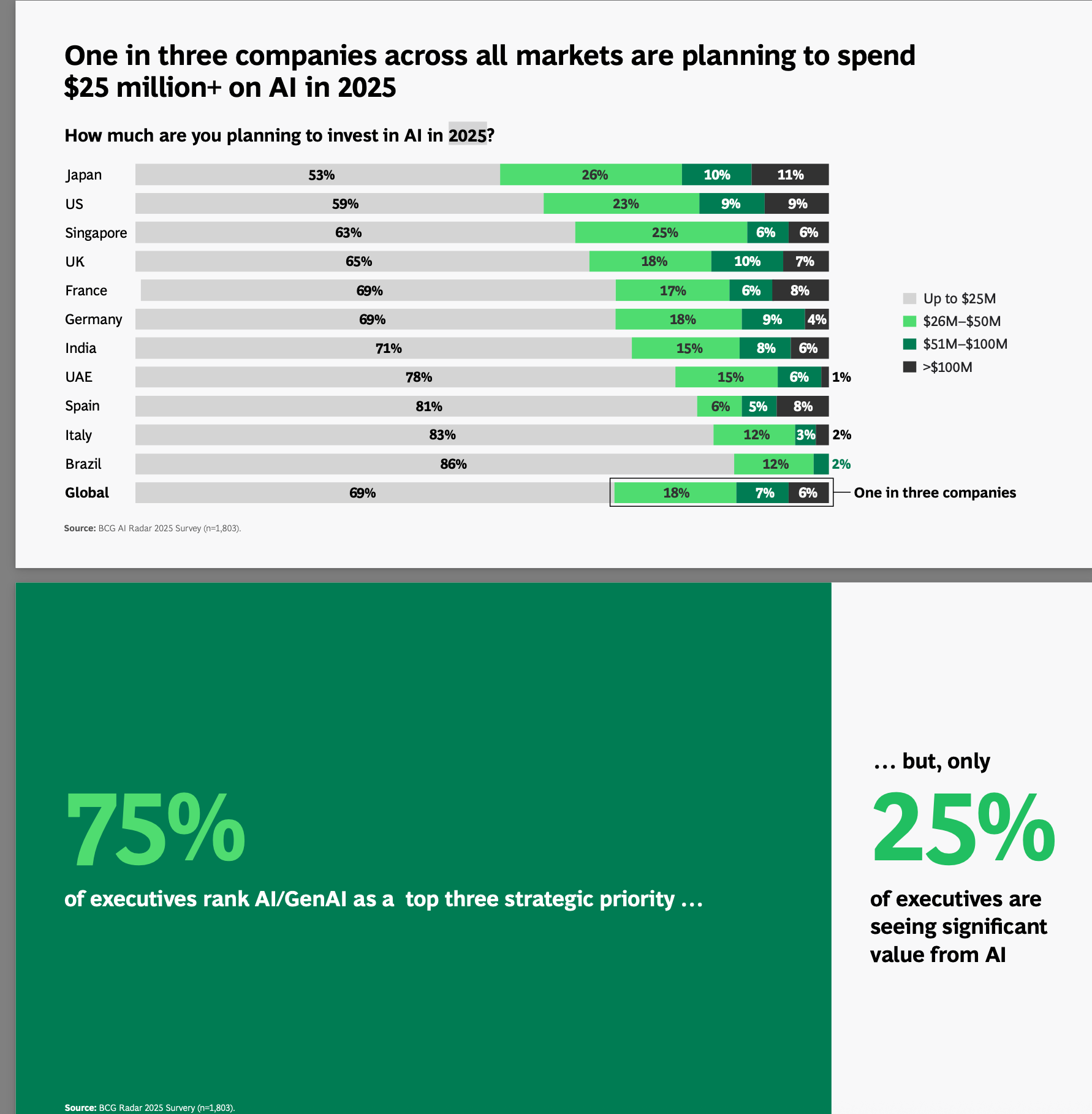Field Notes // June 11 / Ding Dong, It’s the Droid!
Amazon's testing of humanoid delivery robots represents a significant step in the evolution of automated logistics, with potential implications for technology, employment, and consumer services.
Welcome to Field Notes, a weekly scan from Creative Machinas. Each edition curates ambient signals, overlooked movements, and cultural undercurrents across AI, creativity, and emergent interfaces. Every item offers context, precision, and an answer to the question: Why does this matter now?
FEATURED SIGNAL
Amazon ‘testing humanoid robots to deliver packages’
Amazon is developing AI-powered humanoid robots to assist with package deliveries, marking a significant advancement in logistics automation. The company is developing advanced AI software to enable these robots to perform complex, multistep tasks and interpret natural language commands. This initiative builds upon previous trials with robots from Agility Robotics, aiming to enhance the robots' ability to operate in unpredictable real-world environment. (via The Guardian)
Why it matters.
Amazon’s push to integrate humanoid robots into last-mile delivery represents more than a technical experiment—it’s a signal of shifting power dynamics in the future of logistics and labour. The development of a dedicated “humanoid park” to train and test robots capable of leaping from delivery vans and navigating real-world environments suggests Amazon is accelerating its ambition to automate physical delivery work. While the company maintains that robots will assist, not replace, human employees, the trajectory of testing—including real-world trials—hints at a deeper transformation of the workforce. This evolution could redefine delivery roles entirely, requiring workers to transition into supervisory or tech-enabled positions (like “robot managers”), or risk redundancy altogether. As humanoid hardware improves and AI systems gain competence beyond controlled environments, the implications grow: not only for Amazon’s 20,000+ Rivian vans, but for the broader e-commerce sector’s dependence on human couriers. At scale, this could reshape employment patterns, urban infrastructure, and regulatory frameworks.Beyond labour, it raises broader questions about trust, safety, and the thresholds at which machines move from tools to autonomous actors in everyday public spaces. If robots are the new delivery agents, who is responsible when something goes wrong? And how do communities adjust to a future where jobs are not just transformed, but in some cases, dissolved?
How it affects you
Is this the start of another employment earthquake? The use of humanoid robots could lead to faster and more reliable deliveries. By operating alongside human drivers, these robots may improve delivery times and efficiency, enhancing the overall customer experience. The introduction of humanoid robots into public spaces raises questions about societal acceptance and trust in AI-driven services. Public perception will play a crucial role in the successful integration of such technology into daily life.
SIGNAL SCRAPS
» From metaverse wanderers to 3D-rendered cities pulsing with digital life, Tokyo’s Machine Love exhibition reveals how AI, video games, and virtual worlds are redefining art. With works powered by generative AI, game engines, and VR—including a kinetic video sculpture said to be the first “human” born in the metaverse—this boundary-blurring showcase offers a stunning glimpse of creativity’s high-tech future.
» Artificial Power is a strategy-laced 2025 report calling for the public to reclaim agency over AI. It warns that today’s AI systems aren’t just tools—they’re instruments of control, wielded by tech oligarchs under the guise of convenience. With practical steps for organisers, lawmakers, and citizens, the report shifts from critique to action, urging us to challenge the AI power grab before it becomes irreversible
» In a recent blog post, Sam Altman notes that a single ChatGPT query uses just 0.34 watt-hours—about what an oven burns in a second or a high-efficiency lightbulb in a couple of minutes—and only one-fifteenth of a teaspoon of water. As datacenters become more automated, he suggests the cost of intelligence could fall to the price of electricity itself.
SIGNAL STACK
Data is among several essential AI resources in short supply
Companies racing to develop more powerful artificial intelligence are rapidly nearing a new problem: The internet might be too small for their plans. Ever more powerful systems developed by OpenAI, Google and others require larger oceans of information to learn from. That demand is straining the available pool of quality public data online at the same time that some data owners are blocking access to AI companies. Some executives and researchers say the industry’s need for high-quality text data could outstrip supply within two years, potentially slowing AI’s development. (via The Wall Street Journal)
Why it matters
AI’s explosive progress could soon hit a wall: a shortage of high-quality data. Today’s most powerful models, like GPT-4, rely on vast volumes of internet text—but that supply is running out fast. If trends continue, experts predict a critical shortfall in just a few years, stalling AI development or forcing risky workarounds. To compensate, companies are turning to synthetic data or mining alternative sources like YouTube transcripts, but these come with serious risks—including AI systems training on flawed or repetitive material, which could degrade performance. The scramble is so intense, it’s now a secretive arms race. Ultimately, the issue isn’t just technical—it affects the public too. With data being harvested from social media, videos, and online content, it raises urgent questions about ownership, consent, and the long-term sustainability of AI growth.
Consultant behind AI-generated robocalls mimicking Biden goes on trial
A political consultant who sent voters artificial intelligence-generated robocalls mimicking former President Joe Biden last year went on trial in New Hampshire, where jurors are being asked to consider not just his guilt or innocence but whether the state actually held its first-in-the-nation presidential primary. (via AP)
Why it matters
The ability to convincingly replicate voices of public figures undermines trust in communication channels. When individuals cannot distinguish between genuine messages and deepfakes, it fosters skepticism and confusion, weakening the integrity of public discourse. The deployment of AI in this manner poses legal dilemmas, as existing laws may not adequately address the nuances of AI-generated misinformation. The consultant behind the Biden robocalls faced multiple felony charges, highlighting the need for updated legal frameworks to tackle such issues. The misuse of AI for political manipulation is not confined to one country. Similar tactics have been observed worldwide, indicating a broader trend that threatens democratic institutions globally. This underscores the urgent need for robust regulations and public awareness to prevent the exploitation of AI technologies in undermining democratic processes and public trust.
Hollywood Veteran Katzenberg on AI: ‘If Change is Uncomfortable, Irrelevance is Going to be Harder’
Former DreamWorks and Disney exec Jeffrey Katzenberg, who now runs the venture fund WndrCo, has compared the arrival of AI technologies in the business world today to the arrival of computer-generated animation technologies in Hollywood in the 1990s, led by Pixar. Katzenberg has quoted NVIDIA CEO Jensen Huang: “AI isn’t going to replace people. It’s going to replace people that don’t use AI.” (via InnovationLeader)
Why it matters
Katzenberg views AI not as a replacement for human creativity but as a powerful tool that can enhance storytelling. He likens the advent of AI to the introduction of computer-generated imagery (CGI) in the 1990s, which revolutionized animation and visual effects. He predicts that AI could significantly reduce the time and labor required to produce animated films. Previously, creating a world-class animated movie might have taken 500 artists five years; with AI, this could be reduced to a fraction of the time and workforce. Katzenberg emphasizss that embracing AI is crucial for staying relevant in the evolving entertainment landscape. He suggests that those who fail to integrate AI into their workflows risk obsolescence.
Meta Aims to Fully Automate Ad Creation Using AI
Meta’s push to roll out AI-generated, hyper-personalized ads by year’s end signals more than a revolution in marketing—it could transform how news is delivered. Imagine articles that adapt in real time to your location, reading habits, or even mood. While this promises a more tailored, user-friendly experience, it also risks deepening echo chambers and enabling customized political messaging. As AI creeps closer to writing—and rewriting—what we read, the clock is ticking for newsrooms to redefine their role in a machine-shaped media future (via Wall Street Journal)
Why it matters
Meta’s push to fully automate ad creation with AI could transform not just advertising but how we consume all digital content. By allowing brands to generate complete campaigns—text, video, targeting—from a product image and budget, the system lowers barriers for smaller businesses while redefining creative workflows. But the same infrastructure could spill into news and media: articles that adapt to your habits, switch to audio if you're driving, add or remove context based on your knowledge, or even simplify language dynamically. This signals a future where content becomes hyper-personalised—but also raises urgent questions about editorial integrity, trust, and the unseen influence of algorithmic storytelling.
FIELD READING
From Potential to Profit: Closing the AI Impact Gap
BCG’s 2025 AI Radar report reveals a widening gap between AI’s promised potential and its actual impact. While nearly three-quarters of C-suite leaders view AI as a top strategic priority, only a quarter of companies report meaningful returns. The most successful organisations are sharply focused—prioritising a few high-impact use cases, embedding AI into core operations, and investing heavily in people, not just algorithms. Notably, two-thirds are exploring AI agents—autonomous systems that can act independently—marking a possible turning point for enterprise automation. Yet workforce readiness remains a bottleneck: fewer than a third of companies have upskilled even a quarter of their staff. The report calls for a deliberate, transformation-led approach, stressing that the cultural and organisational shifts are just as critical as the tech itself.
A Boston Consulting Group Report says:
Leading companies allocate more than 80% of their AI investments to reshaping key functions and inventing new offerings rather than smaller-scale, productivity-focused initiatives
Two-thirds of companies are exploring the use of AI agents—advanced systems that can act on their own—suggesting that 2025 could mark a turning point for their adoption.
Most companies aim too low, prioritising smaller-scale, productivity-focused initiatives. Leading companies allocate more than 80% of their AI investments to reshaping key functions and inventing new offerings.
Companies are diluting their efforts by placing too many AI bets. Leading companies focus on depth over breadth, prioritising an average of 3.5 use cases, compared with 6.1 for other companies. The leaders anticipate generating 2.1 times greater ROI on their AI initiatives than their peers.
Too few employees have been trained on AI. Less than one-third of companies have upskilled one-quarter of their workforce to use AI. That’s better than a year ago , but far from where companies need to be for workers to feel comfortable with such a job-threatening technology.
Most companies do not track financial KPIs of their AI initiatives.
Why it matters
The report underscores that realising AI's full potential isn't just about adopting advanced technologies; it's about strategically integrating AI into core business processes and investing in the necessary organizational changes. Companies that fail to do so risk falling behind in an increasingly competitive landscape.
DRIFT THOUGHT
If a delivery robot slips on your driveway, does it feel embarrassed? Or are we the only ones still clinging to the idea that work requires dignity?
___
YOUR TURN
Could you see yourself managing a robot workforce? What would that even look like?
As humanoid robots edge closer to real-world delivery roles, some workers may find themselves shifting from doing the task to directing the tech. The rise of the “robot manager” might not be sci-fi for much longer.





